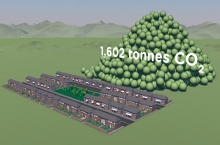Industry urged to broadcast Wood for Good Build with Carbon videos
6 October 2014The Wood for Good marketing campaign is urging companies across the timber industry to embed its new videos, highlighting the carbon benefits of using and building with wood, into their own websites.
The animations, headlined with the campaign slogans Follow the Tree and Build it with Carbon, are based on research findings and information collated by life cycle analysis (LCA) consultants PE International for the Wood for Good Lifecycle Database, which launched earlier this year.
The animations are now live on the Wood for Good website, while a discussion on their production between campaign director Dave Hopkins, chairman Craig White and Carbon Visuals' Antony Turner is on YouTube (www.youtube.com/watch?v=zLyXN6f102I).
The three 90 second films highlight how much CO2 is captured in a single tree, a hectare of woodland (both based on calculations for Sitka spruce) and timber-based buildings, including a house, a housing estate and 200,000 homes, the annual UK construction target set by the Labour party to be achieved by 2020.
"The Lifecycle Database is targeted at the building professional and the timber trade, providing them with facts and figures on using wood they can use in their day-to-day work," said Mr Hopkins. "The animations visualise it in a way that can be understood by any audience, with each cubic metre of carbon represented by a green 33ft diameter sphere, which is the volume it would occupy at normal atmospheric pressure. We'll be showing them to construction industry audiences, policy makers and the general public with the message that we should start building with carbon, rather than emitting it."
The animation voiceovers highlight that, in addition to their content of CO2 sequestered from the atmosphere, wood products require less energy to manufacture, process and often to transport than rival materials, giving them low overall embodied carbon figures.
"They underline that building with timber is the safest, cheapest form of carbon capture and storage, costing in mixed woodland forestry roughly £25-30 per tonne of CO2," said Mr Hopkins. "That's considerably cheaper than the cost of capturing CO2 from industrial processes and pumping them under the North Sea, a solution for dealing with emissions favoured by the oil and power sector."
The Build with Carbon campaign also includes stills based on the same format as the videos. These show how much carbon is stored in specific buildings, such as the nine-storey cross-laminated timber London apartment block Bridport House.
It also highlights that by effectively storing CO2 emissions in timber buildings, a "polluting liability is technically being turned into an asset".
"There are actually proposals for development of the carbon market, which we support, whereby carbon emissions could be accounted for in a property on a balance sheet as an appreciating asset," said Mr Hopkins.
More animations on the same theme will be produced by Carbon Visuals for Wood for Good and the campaign is also considering a similar approach to illustrate the other environmental benefits of using and building with wood. This includes the fact that producing and processing timber uses less water and energy than rival construction materials.
"We'd also like develop a simple visual representation of the operation of timber chain of custody," said Mr Hopkins.
The animation among the first three focusing on CO2 in timber housing was shown during the EU Wood Action Days in Brussels in September, organised to highlight timber's potential contribution to sustainable construction and development to European politicians, particuarly new MEPs. It featured in the Meeting Tomorrow's Housing Challenge seminar, which was moderated by Mr Hopkins with attendees including members of the European Commisson, MEPs and Olli Rehn, vice-president of the European Parliament.
